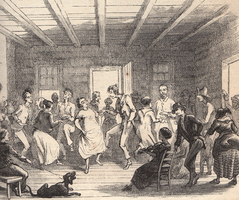 | Back to e-WV
| Back to e-WV
 The West Virginia Encyclopedia
The West Virginia Encyclopedia
 | Back to e-WV
| Back to e-WV
 The West Virginia Encyclopedia
The West Virginia Encyclopedia

Folk dance, like other folk practices, is handed down by demonstration and imitation, passing over time from the original settlers to the present generation. Many ethnic groups participated in the populating of West Virginia, including northern and western Europeans in early times and southern and eastern Europeans in the great emigration accompanying the later industrialization of the state. African-Americans took part in both periods of settlement. Each group brought dance styles and other customs, and some shared dance traditions before arriving here.
Square dance is prominent among the many forms of folk dance in West Virginia. The square dance was once said to have come from Britain and to have survived in the rural areas of America such as West Virginia. This romantic idea, promoted by the legendary folk collector Cecil Sharp, has been challenged. Most scholars now attribute the square dance to a general European tradition shared by early settlers in the region.
Another form of dance, the play-party, was common in areas where dancing was thought to be sinful, fiddle music the sound of the devil, and paired dancing too intimate. Play-party dances involve hand swings and skipping, and players move in a form reminiscent of the square dance. Participants form into rounds rather than squares and move to the song instructions sung by the dancers themselves and not usually to instrumental music or at the directions of a single caller. Although they had their origins in children’s games, play-parties were for adults. As prohibitions against couples dancing diminished, the play-party died as a genre. Except in folk dance revival groups, the play-party is nearly completely forgotten now.
Other forms of folk dancing have persisted in West Virginia or have been brought here by enthusiasts. Clogging, flatfoot, and buck dancing can be seen at folk dance clubs and at the state’s folk festivals. Cloggers are often organized into formal groups, and dance in teams, while flatfoot dancers do it solo. Clogging groups provide both instruction and public performances. More formal and extensive instruction may be obtained at the Augusta Heritage Center in Elkins. Groups such as the Friends of Old Time Music and Dance (Footmad) organize concerts and dances and encourage participation. Among the festivals often featuring traditional dancing are the Forest Festival in Elkins and the Vandalia Gathering in Charleston.
The deliberate teaching of folk dance was part of the folk revival of the 1960s and later. Teachers including Jane George and others taught dance styles indigenous to West Virginia while emphasizing the formal folk dances of the British Isles, including Morris dance and other styles. Meanwhile, rural West Virginians kept up the old-time dance traditions unselfconsciously, gathering for regular weekly or monthly dances at fire halls, community centers, and schoolhouses. One such dance was held at New Creek, Mineral County, with others throughout the state.
Written by Barry Ward
Botkin, Benjamin A. American Play-Party Song. Lincoln: University of Nebraska, 1937, Reprint, Ungar, 1963.
Dalsemer, Robert G. West Virginia Square Dances. New York: Country Dance & Song Society of America, 1982.
Seeger, Mike & Ruth Pershing. Talking Feet: Buck, Flatfoot and Tap: Solo Southern Dance of the Appalachian, Piedmont and Blue Ridge Mountain Regions.. Berkeley, CA: North Atlantic Books, 1992.
Kurath, Gertrude P. "Dance: Folk and Primitive," in Maria Leach, ed, Funk & Wagnalls Standard Dictionary of Folklore, Mythology, and Legend. New York: Funk & Wagnalls, 1949.